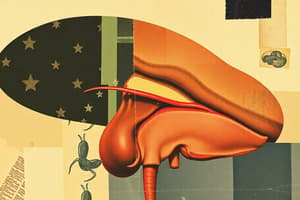Podcast
Questions and Answers
Which system is characterised by presenting secretory epithelial cells that release hormones into the circulatory system?
Which system is characterised by presenting secretory epithelial cells that release hormones into the circulatory system?
- The nervous system
- The digestive system
- The cardiovascular system
- The endocrine system (correct)
What is the main function of the endocrine system?
What is the main function of the endocrine system?
- To control voluntary muscle movements
- To regulate metabolic activity and maintain homeostasis (correct)
- To digest food
- To pump blood throughout the body
Which gland is part of the endocrine system?
Which gland is part of the endocrine system?
- Pancreas (correct)
- Stomach
- Liver
- Small intestine
How do hormones reach their target organs in the body?
How do hormones reach their target organs in the body?
Which part of the neurohypophysis is responsible for discharging the secretion product into the perivascular space in the pars nervosa?
Which part of the neurohypophysis is responsible for discharging the secretion product into the perivascular space in the pars nervosa?
What are the thick lumps stained with intense blue, called Herring bodies, composed of?
What are the thick lumps stained with intense blue, called Herring bodies, composed of?
The axons that run through the neurohypophyseal parenchyma present lateral dilatations that are storage areas for the secretion granules of:
The axons that run through the neurohypophyseal parenchyma present lateral dilatations that are storage areas for the secretion granules of:
The pituicytes present diverse morphology, predominantly similar to that of:
The pituicytes present diverse morphology, predominantly similar to that of:
Specific techniques such as Gomori haematoxylin-phloxin-chromic and that of alum with haematoxylin stain the parenchyma with:
Specific techniques such as Gomori haematoxylin-phloxin-chromic and that of alum with haematoxylin stain the parenchyma with:
Which nuclei in the hypothalamic median eminence produce the hormones of the neurohypophysis?
Which nuclei in the hypothalamic median eminence produce the hormones of the neurohypophysis?
The axons end in the synaptic bulb, which is related to the:
The axons end in the synaptic bulb, which is related to the:
What gives the neurohypophysis a similar appearance to that of the neuropil?
What gives the neurohypophysis a similar appearance to that of the neuropil?
What is the main function of the hypophysis or pituitary gland?
What is the main function of the hypophysis or pituitary gland?
Which part of the hypophysis is made up of the neurohypophysis and adenohypophysis?
Which part of the hypophysis is made up of the neurohypophysis and adenohypophysis?
From which embryonic layers do the neurohypophysis and adenohypophysis derive, respectively?
From which embryonic layers do the neurohypophysis and adenohypophysis derive, respectively?
Which part of the adenohypophysis includes cells expressing growth hormone (GH), prolactin (PRL), corticotropic hormone (ACTH), and gonadotropin (LH and FSH)?
Which part of the adenohypophysis includes cells expressing growth hormone (GH), prolactin (PRL), corticotropic hormone (ACTH), and gonadotropin (LH and FSH)?
Which hormone stimulates GH secretion from the adenohypophysis?
Which hormone stimulates GH secretion from the adenohypophysis?
What is the main activity of the GH hormone?
What is the main activity of the GH hormone?
Which hormone influences the secretion of PRL?
Which hormone influences the secretion of PRL?
What stimulates the secretion of cortisol and androgens from the adrenal cortex?
What stimulates the secretion of cortisol and androgens from the adrenal cortex?
What inhibits the secretion of FSH?
What inhibits the secretion of FSH?
Which type of cells is predominant in the distal part of the adenohypophysis?
Which type of cells is predominant in the distal part of the adenohypophysis?
Which hormone stimulates the secretion of LH and FSH?
Which hormone stimulates the secretion of LH and FSH?
What type of cells express melanocyte-stimulating hormone (MSH) in the pars intermedia of the anterior pituitary gland?
What type of cells express melanocyte-stimulating hormone (MSH) in the pars intermedia of the anterior pituitary gland?
What is the average size of the secretory granules of PRL cells?
What is the average size of the secretory granules of PRL cells?
What stimulates the secretion of TSH?
What stimulates the secretion of TSH?
Which hormone influences prolactinemia levels?
Which hormone influences prolactinemia levels?
Which structure is a continuation of the hypothalamus?
Which structure is a continuation of the hypothalamus?
What inhibits the secretion of LH?
What inhibits the secretion of LH?
Which type of cells join together to form aggregates with age?
Which type of cells join together to form aggregates with age?
Study Notes
- The secretory granules of PRL cells are the largest in adenohypophyseal cells, spherical in shape, highly electrodense, and have an average size between 375-450 nm.
- PRL secretion is influenced by external and internal factors. Prolactinemia levels are regulated by PRH and PIF.
- ACTH cells, also known as corticotropin cells, have a homogeneous distribution, predominantly antero-medial, represent 7% to 10% of the cells in the distal part, and measure 12 to 15 µm.
- ACTH cells have a well-developed RER, a large Golgi complex, and secretory granules of homogeneous electron density.
- ACTH secretion is stimulated by CRH and stimulates the secretion of cortisol and androgens from the adenal cortex.
- LH and FSH cells, also known as gonadotropic cells, are rounded or elongated with an eccentric nucleus, represent 10% of the cells in the distal part, and measure 12 to 15 µm.
- LH and FSH cells have polarity of secretion granules, and their RER and Golgi complex are well-developed.
- LH and FSH control reproductive function, and their secretion is stimulated by GnRH and inhibited by oestrogens and testosterone (LH) and oestrogens and inhibin (FSH).
- TSH cells, also called thyrotropes, are basophilic cells that are scarce (5%), have irregular or angular morphology, measure 12-14 µm, and have the smallest secretory granules (maximum diameter of 150 nm).
- Follicle-stellate cells, 8 to 10 µm cells, do not stain with usual dyes but are seen with markers such as the S100 protein and cytokeratins. They have few organoids, support and maintain the hydroelectrolytic medium, and with age, join together to form aggregates.
- The pars intermedia of the anterior pituitary gland is adjacent to the neurohypophysis, has two types of cells: cells that express melanocyte-stimulating hormone (MSH) and cells that express cytokeratins.
- The median eminence is a continuation of the hypothalamus, the infundibulum or infundibular stalk is a connecting structure, and the pars nervosa or neural lobe is a collection of nerve fibers.
- The neurohypophysis is a dependency of the endocrine neural tube and has three parts: the median eminence, infundibulum or infundibular stalk, and pars nervosa or neural lobe.
Studying That Suits You
Use AI to generate personalized quizzes and flashcards to suit your learning preferences.
Related Documents
Description
Test your knowledge about the secretion and regulation of prolactin (PRL) in the adenohypophyseal cells. Learn about the factors influencing PRL secretion and its regulation by hypothalamic hormones.




